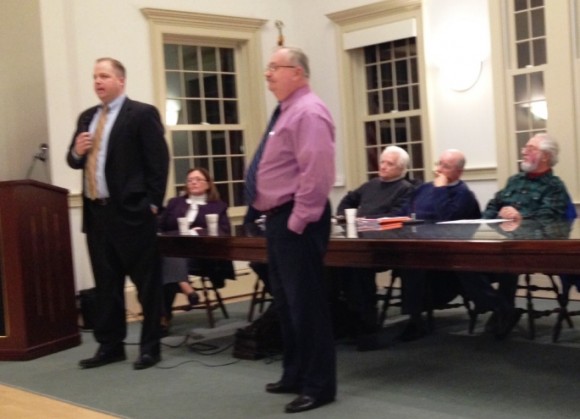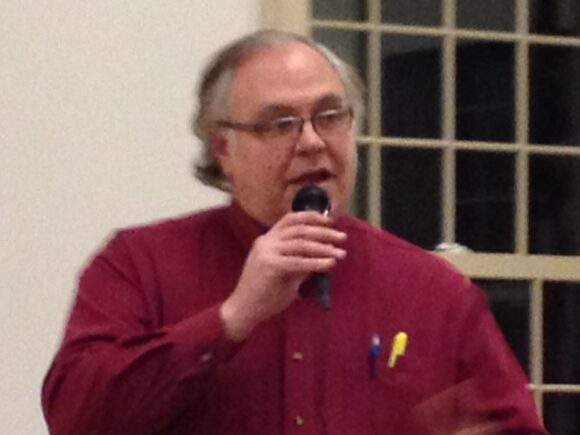
Close to 60 people turned out in Monday night’s rain to attend a meeting in Old Lyme’s Memorial Town Hall about, coincidentally, water — not the stuff we drink, however (though that’s involved), but rather wastewater.
The problem that the Town of Old Lyme is facing up to is that, although it has adopted a sewer-avoidance policy for more than 30 years, it is becoming increasingly unrealistic to stick rigidly to it for two reasons.
Firstly, in the past five years, one Chartered Beach Association — Point of Woods — has already installed sewers that connect to the New London Wastewater Treatment Facility, while two others — Old Colony Beach and Old Lyme Shores — are in the process of making plans to hook up to the New London facility by June 2016. A fourth (unidentified) Beach Association has also begun a study to determine if they should follow suit.
Secondly, there is not only a tacit agreement that there is some level of pollution in the Old Lyme beach area and Long Island Sound due to the housing density in that location, but also a recognition that if nothing is done, the state will step in and impose a solution on the town. This will likely be to hook up to an out-of-town sewer and, according to one of the Information Sheets presented at Monday’s meeting, may not be “in the best interests of the town.”
First Selectwoman Bonnie Reemsnyder opened the presentation by giving a brief history of the water pollution issue as it has affected Old Lyme. She noted, “In the early 80s, the DEP (Department of Environmental Protection) – now the DEEP (Department of Energy and Environmental Protection) – started the effort to get shoreline communities to have sewers.”
In response Old Lyme created a Water Pollution Control Authority (WPCA) and their mission was sewer avoidance. The Information Sheet states, “To support this effort, the Town has monitored ground water pollution, required regular septic pump outs, and aided homeowners in repairs when their septic systems have failed.”
With the increasing number of beach communities implementing or investigating wastewater solutions, the Old Lyme Board of Selectmen took action last year by appointing a Wastewater Management Task Force to review options for wastewater management. One plan had been presented by Lombardo Associates Inc. but Reemsyder said the town wished to evaluate all local wastewater alternatives including a conveyance, community system, which would handle the liquid effluent.
The Task Force is led by former Old Lyme Selectmen Kurt Zemba and includes a number of highly qualified engineers and scientists along with the former chairs of the currently non-operational WPCA. Reemsnyder said the team, which she described as having “impressive resumes,” had concluded that a feasibility study should be carried out as the next step.

Task Force member Doug Wilkinson told the audience, “We believe a solution is possible, which is why we recommended to the town to continue.”
The Task Force selected the firm of Woodard and Curran to perform the feasibility study, which will cost a total of $185,000. An initial $18,000 to apply for the grant funding must be paid in full, but 55 percent of the $185,000 is eligible for reimbursement from the Federal Clean Water Fund.
Reemsnyder explained that, “Timing is of the essence,” because the DEEP requires soil-testing to be carried out in April or early May when groundwater levels are highest. Hence the vote on whether to approve funding for the feasibility study is planned at a Special Town Meeting on Tuesday, April 9, at 7:30 p.m. in the Lyme-Old Lyme Middle School auditorium.
Reemsnyder made it clear that she is hopeful that the feasibility study recommends a wastewater management solution, which will avoid having to hook up the New London facility. She said, “It’s better to keep local control … it’s better for the environment.” The Information Sheet adds, “Homeowners benefit because their drinking water will be protected from contamination from their onsite wastewater systems. The entire community will benefit from cleaner water in Long Island Sound. An alternative conveyance, community system would keep our water resources in our own aquifers, rather than pumping it out of town.”
Additionally, the Information Sheet states, “Groundwater stays within the community, recharging what we use in our daily lives,” and perhaps, most significantly, “When the New London Facility expands, and we believe it must in the future, we will not be expected to pay for the capital expenses of that expansion. Federal dollars for centralized systems are drying up, so this will be costly to the communities that utilize the facility.”
Woodard and Curran Senior Project Manager David Prickett noted that “two potential sites [for the conveyance, community system] had been identified with more to be screened.” Neither he nor any of the Task Force members revealed where the two sites are, but the Information Sheet confirms, “ There is no plan to utilize our current open space, and this is an eco friendly system benefiting the land with no unsightly structures, or any unpleasant residual effects.”
Prickett said his company’s role is “to explore the options,” and Reemsnyder clarified, “Right now, we’re trying to get our arms round this … we’re trying to determine if there’s a viable alternative.”
The area to be included in the study is the shoreline area, roughly from Old Lyme Shores west to White Sand Beach and up to Rte. 156. This area includes approximately 1,400 dwellings but if a residence has a 100 percent compliant system, it may be excluded from the system. The intention at this point is that those who use the new system, if it is implemented, will pay for it, but as the number of users increase, so the cost reduces.
At this time, the Rogers Lake area is not included in the study. Reemsnyder expressed the hope, however, that the Old Lyme Shores and Old Colony Beach proposals may coalesce with the Town’s plans at some point in the future.
The questions raised after the presentation were mostly about who was going to make decisions as the plan unfolded after the feasibility study was complete. One woman asked, “Is this going to be shoved down our throats?” Reemsnyder stressed in response, “This is a very big issue – I suspect it may well rise to the level of a town referendum … everyone should have a voice.”
Another resident asked, “Who will decide whether a septic system is intact?” Reemsnyder’s answer was that ultimately the DEEP would decide.

Sound View Beach President Frank Pappalardo spoke towards the end of the meeting expressing his thanks to the Task Force and commenting, “We have quite a challenge ahead of us, but we’re on the right track.” He said pointedly, “Getting information is the way to move forward.”
The final comment was made by Frank Noe, Old Colony Beach President, who indicated he was “open to recommending the plan to Old Colony.” He added passionately, “We need to clean up Hartford Avenue. Support your community and your town. Let’s make Old Lyme a friendly place so we can all use our properties.”
Reemsnyder closed the meeting by urging those present to come out and vote in support of the feasibility study on April 9.
There will be another information session at the town hall this Saturday morning at 11a.m.
1. Did the town put out to bid on this contract or was only one firm selected?
2. This report notes that only one beach was represented, were there any other beach representatives present at this meeting?
1. The town followed the requirements of the CT DEEP to advertise an RFQ (request for qualifications) in order to objectively choose a firm with which to work, and to qualify for Clean Water Funds (CWF). There were six firms who submitted their qualifications. We are working closely with the DEEP to make sure that we do all things properly. The RFQ was published and all Task Force Meetings, including when the selections were discussed and decided, were public, posted and minutes available within 24 hours after every meeting
2. While we cannot be sure that all beaches were represented at this presentation, there were many people from the general Shoreline Area, including at least 4 of the beach areas. We have also regularly shared information with beach association representatives on minutes, meeting schedules, and these public hearings.